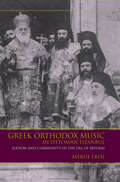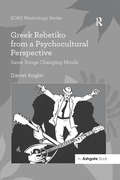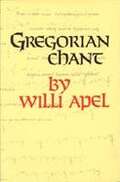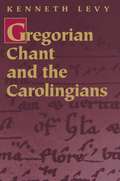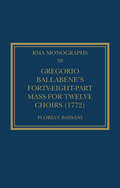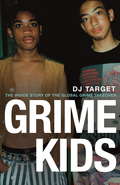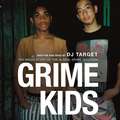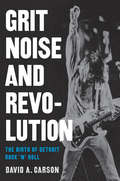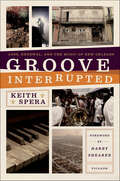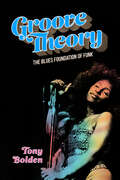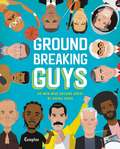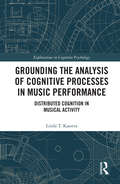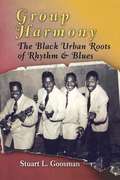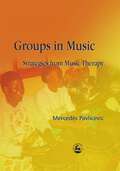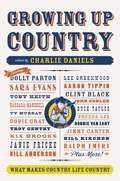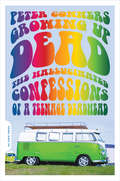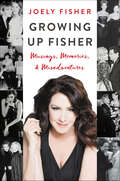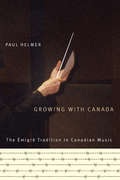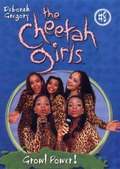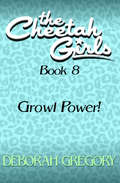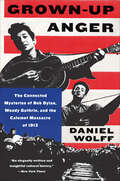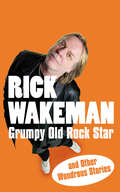- Table View
- List View
Greek Orthodox Music in Ottoman Istanbul: Nation and Community in the Era of Reform (Ethnomusicology Multimedia)
by Merih ErolA study of the musical discourse among Ottoman Greek Orthodox Christians during a complicated time for them in the nineteenth and early twentieth centuries.During the late Ottoman period (1856–1922), a time of contestation about imperial policy toward minority groups, music helped the Ottoman Greeks in Istanbul define themselves as a distinct cultural group. A part of the largest non-Muslim minority within a multi-ethnic and multi-religious empire, the Greek Orthodox educated elite engaged in heated discussions about their cultural identity, Byzantine heritage, and prospects for the future, at the heart of which were debates about the place of traditional liturgical music in a community that was confronting modernity and westernization. Merih Erol draws on archival evidence from ecclesiastical and lay sources dealing with understandings of Byzantine music and history, forms of religious chanting, the life stories of individual cantors, and other popular and scholarly sources of the period. Audio examples keyed to the text are available online.“Merih Erol’s careful examination of the prominent church cantors of this period, their opinions on Byzantine, Ottoman and European musics as well as their relationship with both the Patriarchate and wealthy Greeks of Istanbul presents a detailed picture of a community trying to define their national identity during a transition. . . . Her study is unique and detailed, and her call to pluralism is timely.” —Mehmet Ali Sanlikol, author of The Musician Mehters“Overall, the book impresses me as a sophisticated work that avoids the standard nationalist views on the history of the Ottoman Greeks.” —Risto Pekka Pennanen, University of Tampere, Finland“This book is a great contribution to the fields of historical ethnomusicology, religious studies, ethnic studies, and Ottoman and Greek studies. It offers timely research during a critical period for ethnic minorities in the Middle East in general and Christians in particular as they undergo persecution and forced migration.” —Journal of the American Academy of Religion
Greek Rebetiko from a Psychocultural Perspective: Same Songs Changing Minds (SOAS Musicology Series)
by Daniel KoglinGreek Rebetiko from a Psychocultural Perspective: Same Songs Changing Minds examines the ways in which audiences in present-day Greece and Turkey perceive and use the Greek popular song genre rebetiko to cultivate specific cultural habits and identities. In the past, rebetiko has been associated chiefly with the lower strata of Greek society. But Daniel Koglin approaches the subject from a different perspective, exploring the mythological and ritual aspects of rebetiko, which intellectual elites on both sides of the Aegean Sea have adapted to their own world views in our age of globalized consumption. Combining qualitative and quantitative methods from ethnomusicology, ritual studies, conceptual history and music psychology, Koglin casts light on the role played by national perceptions in the processes of music production and consumption. His analysis reveals that rebetiko persistently oscillates between conceptual categories: it is a music both ours and theirs, marginal and mainstream, joyful and grievous, sacred and profane. The study culminates in the thesis that this semantic multistability is not only a key concept to understanding the ongoing popularity of rebetiko in Greece, and its recent renaissance in Turkey, but also a fundamental aspect of the human experience on the south-eastern borders of Europe.
Green Day: The Secret History (The\secret History Of Rock Ser.)
by Alan CrossAlan Cross is the preeminent chronicler of popular music.Here he looks at Green Day from their founding through 2006.This ebook is adapted from the audiobook.
Gregorian Chant
by Willi ApelThis extensive survey describes the evolutionary processes of its long history as well as its definition and terminology, the structure of the liturgy, the texts, the notation, the rhythm, the tonality, and the methods and forms of psalmody.
Gregorian Chant and the Carolingians
by Kenneth LevyA world-renowned scholar of plainchant, Kenneth Levy has spent a portion of his career investigating the nature and ramifications of this repertory's shift from an oral tradition to the written versions dating to the tenth century. In Gregorian Chant and the Carolingians, which represents the culmination of his research, Levy seeks to change long-held perceptions about certain crucial stages of the evolution and dissemination of the old corpus of plainchant--most notably the assumption that such a large and complex repertory could have become and remained fixed for over a century while still an oral tradition. Levy portrays the promulgation of an authoritative body of plainchant during the reign of Charlemagne by clearly differentiating between actual evidence, hypotheses, and received ideas. How many traditions of oral chant existed before the tenth century? Among the variations noted in written chant, can one point to a single version as being older or more authentic than the others? What precursors might there have been to the notational system used in all the surviving manuscripts, where the notational system seems fully formed and mature? In answering questions that have long vexed many scholars of Gregorian chant's early history, Levy offers fresh explanations of such topics as the origin of Latin neumes, the shifting relationships between memory and early notations, and the puzzling differences among the first surviving neume-species from the tenth century, which have until now impeded a critical restoration of the Carolingian musical forms.
Gregorio Ballabene’s Forty-eight-part Mass for Twelve Choirs (Royal Musical Association Monographs)
by Florian BassaniNeither Spem in alium, the widely acclaimed ‘songe of fortie partes’ by Thomas Tallis, nor Alessandro Striggio’s forty-part Mass is the largest-scale counterpoint work in Western music. The actual winner is Gregorio Ballabene, a relatively unknown Roman maestro di cappella, a contemporary of Giovanni Paisiello, Joseph Haydn and Luigi Boccherini, who composed in forty-eight parts for twelve choirs. His Mass saw only a public rehearsal and was never performed liturgically despite all of Ballabene’s efforts to promote it. On closer inspection, however, the work deserves special consideration as a piece of outstanding combinatory creativity – the product of a talent able to conceive, structure and realise a project of colossal dimensions. It might even be claimed that if Charles Burney had gained knowledge of it, all derogatory comments by nineteenth-century music historians would not have succeeded in extinguishing the interest of later generations. Ballabene’s Mass has remained completely unstudied until today, even though the score survives in prominent collections. This study offers, for the first time, a historical and analytical perspective on this overlooked manifestation of a very individual musical intelligence.
Grime Kids: The Inside Story of the Global Grime Takeover
by DJ TargetAn explosive insider account of grime, from subculture to international phenomenon. *****A group of kids in the 2000s had a dream to make their voice heard - and this book documents their seminal impact on today's pop culture.DJ Target grew up in Bow under the shadow of Canary Wharf, with money looming close on the skyline. The 'Godfather of Grime' Wiley and Dizzee Rascal first met each other in his bedroom. They were all just grime kids on the block back then, and didn't realise they were to become pioneers of an international music revolution. A movement that permeates deep into British culture and beyond. Household names were borne out of those housing estates, and the music industry now jumps to the beat of their gritty reality rather than the tune of glossy aspiration. Grime has shaken the world and Target is revealing its explosive and expansive journey in full, using his own unique insight and drawing on the input of grime's greatest names.
Grime Kids: The Inside Story of the Global Grime Takeover
by DJ TargetFor fans of Wiley, Dizzee Rascal and Stormzy, Grime Kids is the definitive inside story of Grime.'An essential read for anyone with the slightest interest in the birth of Grime' The Wire'Sharp and nostalgic' The ObserverA group of kids in the 90s had a dream to make their voice heard - and this book documents their seminal impact on today's pop culture. DJ Target grew up in Bow under the shadow of Canary Wharf, with money looming close on the skyline. The 'Godfather of Grime' Wiley and Dizzee Rascal first met each other in his bedroom. They were all just grime kids on the block back then, and didn't realise they were to become pioneers of an international music revolution. A movement that permeates deep into British culture and beyond. Household names were borne out of those housing estates, and the music industry now jumps to the beat of their gritty reality rather than the tune of glossy aspiration. Grime has shaken the world and Target is revealing its explosive and expansive journey in full, using his own unique insight and drawing on the input of grime's greatest names.What readers are saying about Grime Kids:'Fantastic depiction of the inception of a genre that has spanned the millennium''Brilliant insight in to grim music from one of the pioneers of the scene''This book really sums up the feeling of being a DJ perfectly'
Grime Kids: The Inside Story of the Global Grime Takeover
by Dj TargetAn explosive insider account of grime, from subculture to international phenomenon. *****A group of kids in the 2000s had a dream to make their voice heard - and this book documents their seminal impact on today's pop culture.DJ Target grew up in Bow under the shadow of Canary Wharf, with money looming close on the skyline. The 'Godfather of Grime' Wiley and Dizzee Rascal first met each other in his bedroom. They were all just grime kids on the block back then, and didn't realise they were to become pioneers of an international music revolution. A movement that permeates deep into British culture and beyond. Household names were borne out of those housing estates, and the music industry now jumps to the beat of their gritty reality rather than the tune of glossy aspiration. Grime has shaken the world and Target is revealing its explosive and expansive journey in full, using his own unique insight and drawing on the input of grime's greatest names.
Grit, Noise, and Revolution: The Birth of Detroit Rock 'n' Roll
by David A. Carson". . . a great blow-by-blow account of an exciting and still-legendary scene. " ---Marshall Crenshaw From the early days of John Lee Hooker to the heyday of Motown and beyond, Detroit has enjoyed a long reputation as one of the crucibles of American pop music. InGrit, Noise, and Revolution, David Carson turns the spotlight on those hard-rocking, long-haired musicians-influenced by Detroit's R&B heritage-who ultimately helped change the face of rock 'n' roll. Carson tells the story of some of the great garage-inspired, blue-collar Motor City rock 'n' roll bands that exemplified the Detroit rock sound: The MC5, Iggy Pop and the Stooges, Mitch Ryder and the Detroit Wheels, SRC, the Bob Seger System, Ted Nugent and the Amboy Dukes, and Grand Funk Railroad. An indispensable guide for rock aficionados,Grit, Noise, and Revolutionfeatures stories of these groundbreaking groups and is the first book to survey Detroit music of the 1960s and 70s-a pivotal era in rock music history.
Groove Interrupted: Loss, Renewal, and the Music of New Orleans
by Keith SperaThe recent history of New Orleans is fraught with tragedy and triumph. Both are reflected in the city's vibrant, idiosyncratic music community. In Keith Spera's intimately reported Groove Interrupted, Aaron Neville returns to New Orleans for the first time after Hurricane Katrina to bury his wife. Fats Domino improbably rambles around Manhattan to promote a post-Katrina tribute CD. Alex Chilton lives anonymously in a battered cottage in the Treme neighborhood. Platinum-selling rapper Mystikal rekindles his career after six years in prison. Jazz trumpeter Terence Blanchard struggles to translate Katrina into music. The spotlight also shines on Allen Toussaint, Pete Fountain, Gatemouth Brown, the Rebirth Brass Band, Phil Anselmo, Juvenile, Jeremy Davenport and the 2006 New Orleans Jazz & Heritage Festival. With heartache, hope, humor and resolve, each of these contemporary narratives stands on its own. Together, they convey that the funky, syncopated spirit of New Orleans music is unbreakable, in spite of Katrina's interruption.
Groove Theory: The Blues Foundation of Funk (American Made Music Series)
by Tony BoldenTony Bolden presents an innovative history of funk music focused on the performers, regarding them as intellectuals who fashioned a new aesthetic. Utilizing musicology, literary studies, performance studies, and African American intellectual history, Bolden explores what it means for music, or any cultural artifact, to be funky. Multitudes of African American musicians and dancers created aesthetic frameworks with artistic principles and cultural politics that proved transformative. Bolden approaches the study of funk and black musicians by examining aesthetics, poetics, cultural history, and intellectual history. The study traces the concept of funk from early blues culture to a metamorphosis into a full-fledged artistic framework and a named musical genre in the 1970s, and thereby Bolden presents an alternative reading of the blues tradition. In part one of this two-part book, Bolden undertakes a theoretical examination of the development of funk and the historical conditions in which black artists reimagined their music. In part two, he provides historical and biographical studies of key funk artists, all of whom transfigured elements of blues tradition into new styles and visions. Funk artists, like their blues relatives, tended to contest and contextualize racialized notions of blackness, sexualized notions of gender, and bourgeois notions of artistic value. Funk artists displayed contempt for the status quo and conveyed alternative stylistic concepts and social perspectives through multimedia expression. Bolden argues that on this road to cultural recognition, funk accentuated many of the qualities of black expression that had been stigmatized throughout much of American history.
Groundbreaking Guys: 40 Men Who Became Great by Doing Good
by Stephanie True Peters Shamel WashingtonAn illustrated book of biographies highlighting the inspiring and innovative qualities of forty very different men throughout history, for fans of Heroes for My Son and Good Night Stories for Rebel Girls.Our history books are full of great men, from inventors to explorers to presidents. But these great men were not always good men. It's time for our role models to change. This book pays tribute to Mr. Rogers, Barack Obama, Hayao Miyazaki, and more: men whose masculinity is grounded in compassion and care. These men have varying worldviews and are accomplished in a range of fields, but they share important commonalities. They served their communities. They treated people with respect. They lifted others up. And they went on to create change, inspire others, and, indeed, do great things--not in spite of their goodness, but because of it.These men's stories will educate, entertain, and encourage the next generation of writers, activists, entrepreneurs, and other leaders of all genders to do better and be better--to be truly groundbreaking.
Grounding the Analysis of Cognitive Processes in Music Performance: Distributed Cognition in Musical Activity (Explorations in Cognitive Psychology)
by Linda T. KaastraThrough the systematic analysis of data from music rehearsals, lessons, and performances, this book develops a new conceptual framework for studying cognitive processes in musical activity. Grounding the Analysis of Cognitive Processes in Music Performance draws uniquely on dominant paradigms from the fields of cognitive science, ethnography, anthropology, psychology, and psycholinguistics to develop an ecologically valid framework for the analysis of cognitive processes during musical activity. By presenting a close analysis of activities including instrumental performance on the bassoon, lessons on the guitar, and a group rehearsal, chapters provide new insights into the person/instrument system, the musician’s use of informational resources, and the organization of perceptual experience during musical performance. Engaging in musical activity is shown to be a highly dynamic and collaborative process invoking tacit knowledge and coordination as musicians identify targets of focal awareness for themselves, their colleagues, and their students. Written by a cognitive scientist and classically trained bassoonist, this specialist text builds on two decades of music performance research; and will be of interest to researchers, academics, and postgraduate students in the fields of cognitive psychology and music psychology, as well as musicology, ethnomusicology, music theory, and performance science. Linda T. Kaastra has taught courses in cognitive science, music, and discourse studies at the University of British Columbia (UBC) and Simon Fraser University. She earned a PhD from UBC’s Individual Interdisciplinary Graduate Studies Program.
Group Harmony
by Stuart L. GoosmanIn 1948, the Orioles, a Baltimore-based vocal group, recorded "It's Too Soon to Know." Combining the sound of Tin Pan Alley with gospel and blues sensibilities, the Orioles saw their first hit reach #13 on the pop charts, thus introducing the nation to vocal rhythm & blues and paving the way for the most successful groups of the 1950s.In the first scholarly treatment of this influential musical genre, Stuart Goosman chronicles the Orioles' story and that of myriad other black vocal groups in the postwar period. A few, like the Orioles, Cardinals, and Swallows from Baltimore and the Clovers from Washington, D.C., established the popularity of vocal rhythm & blues nationally. Dozens of other well-known groups (and hundreds of unknown ones) across the country cut records and performed until about 1960. Record companies initially marketed this music as rhythm & blues; today, group harmony continues to resonate for some as "doo-wop."Focusing in particular on Baltimore and Washington and drawing significantly from oral histories, Group Harmony details the emergence of vocal rhythm & blues groups from black urban neighborhoods. Group harmony was a source of empowerment for young singers, for it provided them with a means of expression and some aspect of control over their lives where there were limited alternatives. Through group harmony, young black males celebrated and musically confounded, when they could not overcome, complex issues of race, separatism, and assimilation during the postwar period.Group harmony also became a significant resource for the popular music industry. Goosman interviews dozens of performers, deejays, and industry professionals to examine the entrepreneurial promise of midcentury popular music and chronicle the convergence of music, place, and business, including the business of records, radio, promotion, and song writing.Featured in the book's account of the black urban roots of rhythm & blues are the recollections of singers from groups such as the Cardinals, Clovers, Dunbar Four, Four Bars of Rhythm, Five Blue Notes, Hi Fis, Plants, Swallows, and many others, including Jimmy McPhail, a well-known Washington vocalist; Deborah Chessler, the manager and songwriter for the original Orioles; Jesse Stone, the writer and arranger from Atlantic Records; Washington radio personality Jackson Lowe; and seminal black deejays Al ("Big Boy") Jefferson, Maurice ("Hot Rod") Hulbert, and Tex Gathings.
Groups in Music: Strategies from Music Therapy
by Mercedes PavlicevicMusic in Groups happens all the time: in the street, the classroom, in music colleges, community centres, hospitals, prisons, churches and concert halls; at raves, weddings, music festivals, public ceremonies, music therapy sessions, group music lessons, concerts and rehearsals. Some group musicking seems to 'work' (and play) better than others; some sessions feel exhausting even if things are going well; and at other times, we can't begin to explain the complex musical and relational textures of group music work to funders, employers, friends, colleagues, or line managers. In this book, music therapist Mercédès Pavlicevic develops a broad-based discourse to describe, analyse and guide the practice of group musicking, drawing on her own extensive experience. The text is illustrated with vignettes drawn from a range of formal and informal settings that include spontaneous public occasions, collective rituals, special and mainstream education, music therapy, the concert hall, the music appreciation group and community work. This book makes you think about balancing individual and group needs, the development of group time, dealing with over-enthusiastic performers who 'hog' the group sound, undercurrents in music groups, the complications of dealing with institutions, preparing music listening programmes and buying instruments for group work - if you're involved in any kind of group musicking, this book is for you.
Growing Up Country: What Makes Country Life Country
by Charlie DanielsFrom Growing Up Country: "I learned early in life that country is not a place on a map. Country is a place in your heart. In your soul. In the very depth of your being." --Bill Anderson. "One of the things I like most about country life is that nothing much has really changed ... My grandchildren and I are still walking and hunting in the same woods and fishing in the same creeks as I did with my father." --President Jimmy Carter. "Food was at the heart of our home. And, other than those troublesome vegetables, I loved all of it. We fried everything--we'd have even fried water if we could've." --Keith Anderson. "I can't imagine what my life would have been without peaceful days, mountain streams, homegrown and home-cooked food, country church, and all-day singing with dinner on the grounds with family and friends." --Dolly Parton. "Growing up country--there's nothing like it. It's growing up with your grandmother and granddaddy around ... it's a lot of love when you need it, great cooking in the kitchen, and always being real." --Eddie Montgomery. Blackberry pie on the window ledge. The Grand Ole Opry on the radio. Sunday dinners on the table. Families swinging on the front porch after a hard day's work. It's all part of the country way of life. Here, legendary country music singer Charlie Daniels introduces and edits a collection of heartfelt essays from an all-star cast of contributors on what it means to grow up country. United by a love of music, these notables show us that country means more than just the twang of a guitar. They share a belief in hard work, integrity, strength of character, and having the courage not to quit. The stories here tell of rustic upbringings and rich spirits, of parents who believed in tough love and old-fashioned common sense, and of a strong sense of community, pride in your country, and a love of the natural world. You'll get an intimate glimpse into the lives of: Country music royalty and all-time greats such as Dolly Parton, Barbara Mandrell, Brenda Lee, Dobie Gray, and Lee Greenwood; Southern rock gods such as Gary Rossington and Donnie Van Zant; The newest crop of stars such as Sara Evans, Toby Keith, and Clint Black; Special guests such as former president Jimmy Carter, and seven-time all around rodeo champion Ty Murray. These snapshots show how living country has allowed our favorite singers, songwriters, and stage performers to make a career out of doing what they love while never forgetting that when you've grown up country, home isn't just a place where you live, it's a state of the heart.
Growing Up Dead: The Hallucinated Confessions of a Teenage Deadhead
by Peter ConnersA colorful journey from straight-laced suburban kid to ?DeadheadOCO nomad to mid-thirties dad, against the backdrop of the late OCO80s and mid-OCO90s"
Growing Up Fisher: Musings, Memories, & Misadventures
by Joely FisherActress, director, entertainer Joely Fisher's touching, down-to-earth memoir filled with incredible, candid stories about her life, her famous parents, and how the loss of her unlikely hero, sister Carrie Fisher, ignited the writer in her.Growing up in an iconic Hollywood Dynasty, Joely Fisher knew a show business career was her destiny. The product of world-famous crooner Eddie Fisher and ’60s sex kitten Connie Stevens, she struggled with her own identity and place in the world on the way to a decades-long career as an acclaimed actress, singer, and director. Now, Joely shares her unconventional coming of age and stories of the family members and co-stars dearest to her heart, while stripping bare her own misadventures. In Growing Up Fisher, she recalls the beautifully bizarre twist of fate by which she spent a good part of her childhood next door to Debbie Reynolds. She speaks frankly about the realities of Hollywood—the fame and fortune, the constant scrutiny. Throughout, she celebrates the anomaly of a two-decade marriage in the entertainment industry, and the joys and challenges of parenting five children, while dishing on what it takes to survive and thrive in the unrelenting glow of celebrity. She speaks frankly about how the loss of her sister Carrie Fisher became a source of artistic inspiration. Fisher’s memoir, with never-before-seen photos, will break and warm your heart.
Growing with Canada: The Émigré Tradition in Canadian Music (Arts Insights Series #6)
by Paul HelmerBased on years of detailed and extensive interviews, and supplemented by a wide range of archival material, Growing with Canada showcases the men and women who came to Canada and the roles they played in developing the country's musical culture. Paul Helmer shows that émigrés were at the centre of the new musical milieu and uses the lively testimony of those involved to weave together the larger story of post-war Canadian music performance, production, and education. By introducing the sounds and techniques of their homelands, émigré artists were able to overcome the dominating British presence in post-secondary music education - vastly expanding the role music played in universities - while pioneering the performance and production of opera in Canada. From British Columbia to Newfoundland, they served as educators, teachers, and administrators as well as outstanding performers, conductors, composers, music historians, radio and television producers, and benefactors.
Growl Power (Cheetah Girls #8)
by Deborah GregoryWhen Aquanette and Anginette go back to Houston to visit their mom for Thanksgiving, they cause a big stir in their hometown with their new "cheetah-ness". The rest of the girls then join the twins and turn on their "growl power" to get one step closer to fame.
Growl Power!: Growl Power (The Cheetah Girls #8)
by Deborah GregoryIt&’s Thanksgiving, and Aquanette and Angie Walker are headed home to Houston to wow their old friends with stories of life in the Big Apple. But in between eating, laughing, and being spooked by their grandpa&’s funeral home, these outrageous twins have something bigger on their minds: getting the Cheetah Girls a record deal!First they have to find their way into the concert for Karma&’s Children, Texas superstars who have been making Angie and Aqua jealous for as long as they can remember. But they&’ll have to put their jealousy aside if they want to get up on that stage in front of the five thousand screaming fans who will make this the best Thanksgiving in Cheetah Girl history.
Grown-Up Anger: The Connected Mysteries of Bob Dylan, Woody Guthrie, and the Calumet Massacre of 1913
by Daniel WolffA brilliantly intertwined account of two revolutionary musicians, a miners’ strike, and a deadly tragedy: “Reads like a historical detective story.” —The New York Times Book ReviewAt thirteen, when he first heard Bob Dylan’s “Like a Rolling Stone,” Daniel Wolff recognized the sound of anger. When he later discovered “Song for Woody,” Dylan’s tribute to folk musician Woody Guthrie, Wolff fixed on it as a clue to a distinctive mix of rage and compassion. That clue led back to Guthrie’s “1913 Massacre”—a memorial song about the horrific conclusion to a union Christmas party in Calumet, Michigan.Following the trail from Dylan to Guthrie to a tragedy that claimed seventy-four lives, Wolff found himself tracing a century-long line of anger. From America’s early industrialized days up to the present, the battle over economic justice keeps resurfacing: on a freight car in California, on a joyride through New Orleans, in a snowy field in Michigan. At the stunning conclusion—as the mysteries of Dylan, Guthrie, and the 1913 tragedy connect—the reader discovers a larger story, purposely distorted and buried in time.A tour de force of storytelling years in the making that chronicles the struggles between the haves and have-nots, Grown-Up Anger is both a dual biography of two legendary songwriters and a murder mystery. It also serves as a history of labor relations and socialism, big business and greed in twentieth-century America—all woven together in one epic saga.“A fascinating and relevant whirlwind examination of music, economic injustice, and two American icons.” —Booklist (starred review)“A masterful tale of music, social, and economic history . . . A dazzling, richly researched story impeccably told.” —Kirkus Reviews (starred review)
Grumpy Old Rock Star: and Other Wondrous Stories
by Rick WakemanAround about August 1948, Mr and Mrs Cyril Wakeman had an early night and some time later, at Perivale in Middlesex, Mrs Wakeman produced a bonny baby son. They named him Richard, but he quickly became known as Rick. Rick was a likeable little fellow who had a talent for the piano and for making trouble. Music became Rick's life - he joined a popular music group called Yes and became a legend. Much later he became a Grumpy Old Man who appears on Countdown, hosts a hugely popular radio show on Planet Rock and performs a one-man show telling stories about his rather extraordinary life.Which is where this book you are holding comes in. Mr Wakeman is simply one of the great storytellers of our age - let's face it, he has some fabulous material. It seemed a shame that some of the funniest yarns should not be more widely known. So he accepted some cash and here we are.Curl up by the fire with a Grumpy Old Rock Star and your nearest and dearest. We defy you not to want to read it aloud and laugh.
Grundlagen der kognitiven Musiktheorie: Wie Harmonie, Melodie und Rhythmus das emotionale Erleben von Musik bestimmen
by Reinhard BlutnerDas Buch unternimmt den Versuch, eine Darstellung der modernen Musiktheorie zu geben, die wesentlich von Einsichten der Kognitionswissenschaften bestimmt ist. Das Buch wendet sich somit an Leser*innen, die eine Verbindung suchen zwischen kognitiver Psychologie, Linguistik, Neurowissenschaft auf der einen Seite und der Musikwissenschaft auf der anderen. Das vorliegende Werk basiert auf naturwissenschaftlichen Sockeln. Die Darstellung geht dabei in vielerlei Hinsicht über das hinaus, was in traditionellen Musiktheorien vermittelt wird. Es wird nämlich versucht, die mutmaßlichen Gesetze der Musik zu finden und zu begründen, soweit dies nach dem gegenwärtigen Stand der Wissenschaft möglich ist.
